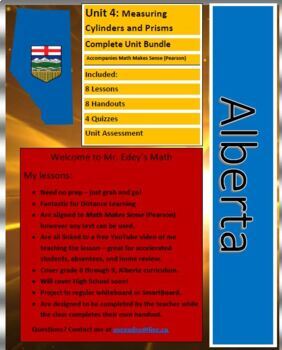
Measuring Prisms and Cylinders
Volume Of Prisms And Cylinders
'In this unit, students will use nets to create three-dimensional solids. They will explore the faces of various nets to make connections between the area of the 2-D shape and the surface area of a given 3-D object. Through such exploration, students will develop and apply formulas for determining the surface area of right prisms and right cylinder. They will then explore the amount of space enclosed within prisms and cylinders, and develop and apply formulas for determining the volume of these solids. Throughout the unit, students will be encouraged to draw diagrams and models to help them visualize the 3-D objects that are described. Developing a good understanding of surface area and volume of 3-D objects will help students analyze situations in their own lives. Activities such as painting a room, wrapping a present, filling a water bottle, putting siding on a house, tracking waste management, and determining the amount of concrete required for a project all require an understanding of surface area and volume. Students will gain an appreciation of these concepts through relevant problem solving activities.' - Grade 8 Curriculum Guide
Below are most of what we did (or will do) in class. For the most part. I always reserve the right to change things up as needed. So it is not a complete list, but, it should be pretty close.
Start studying Math 8 Unit 4: Measuring Prisms and Cylinders. Learn vocabulary, terms, and more with flashcards, games, and other study tools. Powered by Create your own unique website with customizable templates. Grade 8 Math: Final Exam Review Unit 4: Measuring Prisms and Cylinders Lesson 4.3: Surface Area of a Right Rectangular Prism 1. Find the surface area of a rectangular. Powered by Create your own unique website with customizable templates.
Measuring Prisms and Cylinders
'In this unit, students will use nets to create three-dimensional solids. They will explore the faces of various nets to make connections between the area of the 2-D shape and the surface area of a given 3-D object. Through such exploration, students will develop and apply formulas for determining the surface area of right prisms and right cylinder. They will then explore the amount of space enclosed within prisms and cylinders, and develop and apply formulas for determining the volume of these solids. Throughout the unit, students will be encouraged to draw diagrams and models to help them visualize the 3-D objects that are described. Developing a good understanding of surface area and volume of 3-D objects will help students analyze situations in their own lives. Activities such as painting a room, wrapping a present, filling a water bottle, putting siding on a house, tracking waste management, and determining the amount of concrete required for a project all require an understanding of surface area and volume. Students will gain an appreciation of these concepts through relevant problem solving activities.' - Grade 8 Curriculum Guide
Prisms And Cylinders Worksheet
Below are most of what we did (or will do) in class. For the most part. I always reserve the right to change things up as needed. So it is not a complete list, but, it should be pretty close.
